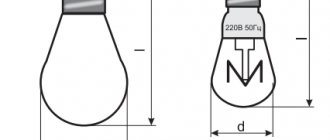Modern household lamps are safe and easy to use, but sometimes their users encounter emergency situations, such as a lamp exploding when the light is turned on. To some extent this can be dangerous, but more often it is simply unpleasant and costly. To fix and prevent this, you need to understand the reasons for this behavior of the equipment and how to fix the problem.
How does a light bulb work?
First of all, you need to understand how light bulbs function. You can consider their operating principle using the example of an incandescent lamp. The current passes through a thin spiral made of tungsten. The melting point of this metal is quite high. Tungsten filament can heat up to 2500°. When the coil gets hot, it emits light.
Inside the flask is filled with gas, such as argon or a mixture of gases. Under its pressure, the rate of destruction of the tungsten filament decreases. But still, over time, it breaks down into small particles. Then weak spots appear on the conductor where it can break.
In gas-discharge lamps, the gas inside the bulb glows. The glow occurs under the influence of an electric charge.
For what reasons do light bulbs in a chandelier often burn out?
Let's figure out why lamps can often fail. The first reason is low quality products. Many people buy Chinese-made lamps, and such purchases, as you know, are a lottery: it may work, or it may not.
However, there are a number of other factors. These include high voltage in the electrical network. As you know, it should be 220 volts, but most often it is unstable and “dances” in the range of 210-235 volts. Such deviations are included in the standards and are therefore taken into account in the production of lighting devices. Such jumps have a negative effect on the tungsten filament.
Even a slight deviation can cause its failure. And the point here is this. The thread heats up to a temperature of 2500 degrees, and as the voltage increases, the metal begins to actively evaporate. Therefore, the thread becomes thinner and breaks. This can be prevented in various ways:
When purchasing a new light source, pay attention to the voltage range for which it is designed. It is best to choose a product where it is up to 245 V
After all, the higher the upper indicator, the less likely it is that the lamp will fail, that is, burn out. Buy energy-saving light bulbs. They are not “afraid” of power surges. Get dimmers, voltage stabilizers, overvoltage sensors or special protective blocks.
In addition, the reason that the light bulb burns out may be a faulty socket. Most often they are made from low quality plastic. Moreover, some cartridges are designed for power up to 40 Watts (they are used in multi-lamp lamps). Consumers may simply not know this, so they purchase them, and then screw in a 60, 75 or even 100 Watt lighting fixture. As a result, the cartridge simply cracks and burns out.
But even if you comply with all technical standards, it happens that the lamps still burn out and quite often. Another reason why this happens may be oxidation of the cartridges. Signs of this problem are:
- crackling sound when you turn on the light;
- change in light brightness over time.
What to do in this case? It is necessary to monitor the condition of the cartridge and clean it if necessary. If it “looks really bad,” then the best thing to do is replace it.
In addition, there are a number of other reasons why lamps burn out quickly. Many consumers, trying to save electricity, always turn off the lights behind them. True, they do not take into account that it is also impossible to turn it on after a couple of minutes. The fact is that when electricity is supplied, the current is much greater than when the light bulb is simply on. Therefore, if you “flick” the switch back and forth, you can burn the tungsten filament. Most often, a rupture occurs at the moment when current is applied to it.
Another reason is problems with the switch. If it becomes unusable, replace it immediately, as it can cause a short circuit, which will cause the lighting fixture to burn out.
The next problem is low temperatures and the influence of various mechanical influences. If you plan to use incandescent lamps in places where the lamp is exposed to mechanical stress, for example, increased vibrations, then remember that tungsten filaments are very sensitive to them. Moreover, starting at low temperatures reduces the metal resistance, which leads to filament burnout.
The next reason is an incorrectly selected connection diagram. To save money, some consumers use a serial connection of all light sources to one wire. If the contacts are faulty, the cartridges will begin to oxidize, the load will increase, which will ultimately lead to a voltage drop.
How lamps explode
As you know, all household appliances are powered by a 220 V AC network, which is constantly changing. When the light source coil cools, its resistance decreases by 10 times. The maximum permissible voltage for a regular light bulb is 240 V.
If, when it was turned on, the coil was cold and the voltage was maximum, then the lamp would quickly burn out or explode. For the same reason, air can get inside the flask, which is heated by the spiral, and then the bulbs burst.
During operation, the lamp body is sealed, the bulb cavity is evacuated or filled with gas. During an explosion, the pressure on the inside and outside of the body stabilizes, so a pop occurs.
Changes in temperature and humidity
The rarest reason, but it also occurs. In the case of a serious difference in temperature, the reason lies in the excess pressure that appears inside the bulb, which results in the explosion of the light bulb. If the contacts in the cartridge become damp, the current in the circuit increases, up to a short circuit. If you switch to more modern lamps that are resistant to both temperature changes and too high voltage in the network, the first problem can somehow be circumvented. But if the problem is that the contacts are damp, this is much worse, and you won’t be able to get away with a simple replacement.
LED lamp
Today the most promising are LED lamps. Firstly, they are more durable than incandescent lamps, and secondly, they are many times more economical in terms of power supply. They are, of course, more expensive, but in the long run they fully pay for themselves. In addition, sellers usually give them at least a one-year warranty.
Why do light bulbs explode when turned on?
If you don’t know why the light bulbs in the chandelier explode when turned on, then try to figure out the problem yourself. The most common reason is the use of a light source of dubious quality. But, if the situation repeats itself, and you have tried devices from different manufacturers, you will have to figure it out.
A possible explosion can be caused by power surges, problems with wiring, design of lampshades, mismatch between the power of the lamp and the lighting fixture, etc. There can be many reasons for damage to the light source, so they should be considered in more detail.
Ventilation of the ceiling
If you are using a regular light bulb and the lamp has closed shades, then be prepared for it to explode. This is due to the fact that the light source heats up during operation. If the lamp shade of a lighting device is partially or completely closed, then the heat simply cannot escape outside. Then the lamp will overheat.
Due to constant temperature changes, the adhesive base of the base is destroyed, and it gradually separates from the light bulb. When air enters the bulb when the lamp is turned on, it explodes.
To improve the ventilation of the lampshade, you can drill holes in it (if the body is metal). Then the air will circulate freely, and the light source will not overheat as much.
To restore air exchange in a glass lampshade, in the area where it is attached with a washer, place 3 pieces of dense material (non-flammable). Then the air will come out and the lamp will not explode.
Mains voltage
A common cause of damage to the integrity of a light bulb is power surges. For more modern electrical appliances, stabilizers are connected to maintain a constant load current in the network. Then the equipment works longer and without problems.
Review of causes of glow
What to do if the LED lamp is on? There are several reasons why, after turning off the lighting device, the LED lamp continues to burn, even dimly or weakly:
- poor-quality insulation in a section of the electrical circuit or any other electrical wiring malfunction;
- the switch to which the LED lamp is connected is backlit;
- low-quality emitters are used in the design of the lighting source;
- special functionality of the lighting element.
Is this glow dangerous? This problem does not pose any danger to the wiring, but the service life of LED bulbs will be noticeably reduced if they constantly flicker or glow dimly.
If the switching device is in the off position, and the emitter still glows and burns, then it is best to check the last three factors first. This is explained by the fact that it is very difficult to find weak insulation areas in electrical wiring.
In order to do this, it is necessary to create special conditions, as a result of which a high voltage is applied to the circuit for one minute to cause a breakdown. The section of the circuit that causes the lighting element to glow after the switch is turned off will need to be opened. Moreover, if the electrical wiring was installed in a hidden way, then opening it will lead to damage to the integrity of the wall.
It is important to know! There are many situations where when LED light sources are connected to a backlit switch, they function differently. This occurs due to the fact that the lighting element, which is installed in the switching device, closes the circuit and, accordingly, passes a small current. This is what charges and allows the light bulb to glow when the switch is off
This is what charges and allows the light bulb to glow when the switch is off.
Another problem why an LED lamp glows in the dark is the low cost of the product. If you purchased a poor quality LED light bulb, this can also lead to a similar phenomenon. This is due to the fact that there is some kind of error in the board. But it also happens that the emitter burns dimly due to the fact that it has its own peculiarity in the functioning of the structure.
We are talking about the processes that occur in capacitors when a load is applied to the lighting element. When electric current passes through the circuit, the capacitor stores energy, and then after the load is stopped, it continues to keep the elements glowing.
Another fairly common reason why LED lamps glow when the switch is off is incorrect connection. You can learn more about this from the video:
Useful tips for those whose lamps explode
If a lamp exploding in your apartment is not uncommon for you, then follow the following expert advice:
- Replace conventional light bulbs with halogen or LED light sources with a power supply. Their price is a little higher, but they last much longer.
- If you have old wiring and switches, try to replace them as soon as possible.
- Buy light sources from trusted manufacturers, such as Philips. They use only high-quality parts when making lamps. When choosing a lighting element, pay attention to its appearance, and also study the characteristics.
- Select light bulbs and fixtures of the same power.
- Do not connect conductors by twisting, use terminal connections.
If after the lamp explosion the base remains in the lamp, then de-energize the room and unscrew it with needle-nose pliers with insulated handles.
Why can't it be done?
Main safety measures:
- Don't turn on the air conditioner. Mercury from a light bulb can settle inside and, after cleaning, spread throughout the room.
- Do not throw waste down the drain.
- Do not use a vacuum cleaner for cleaning - mercury particles may remain inside it.
- Take children and animals out of the room, and ask other family members not to enter until you finish cleaning.
- Do not touch the fragments with bare hands. Use rubber gloves, or better yet, a thick sheet of paper, cardboard, rag or paper towel.
Is it worth calling the Ministry of Emergency Situations?
You can find recommendations to call the Ministry of Emergency Situations to remove possible mercury compounds. However, if only 1 lamp breaks, this can be called unnecessary.
If you follow safety precautions and are careful, you can remove everything yourself. Another thing is if several light bulbs break at once (for example, you were carrying them and dropped them), or if a thermometer broke - in such cases it is better, of course, to contact the Ministry of Emergency Situations.
Lamp life
Most often, lamps with tungsten filament, fluorescent, halogen and LED light sources are used in residential premises. The duration of their work depends on the technology used:
- Conventional lamps last up to 1000 hours. However, after 750 hours of burning, the light becomes dimmer.
- LED lamps can operate for about 50,000 hours (up to 15 years). However, in reality, their service life is reduced to 5 years, but this is also a better result compared to other types of lamps.
- Fluorescent light sources can operate for 20,000 hours. However, this is only possible if the following conditions are met: infrequent switching on, no voltage drops.
- Halogen devices are equipped with a filament that is protected from rapid destruction by a buffer gas. Therefore, their rated life is greater than that of conventional light bulbs - about 4000 hours.
To extend the life of the light bulbs, it is recommended to use a power supply.
Poor quality products
Unfortunately, the main reason for LED burnout is poor build quality. In our search for cheap LED products, we often fall for the trick of Chinese brands - bright light bulbs that, as advertising, shine quite well on the stand and at the same time have a stylish design. The fact is that most LED products from China are manufactured in such a budget version that the light bulbs burn out due to the lack of elements for protecting the LEDs from surge current in the driver circuit. As a result, during voltage surges, the current increases, due to which the LEDs heat up above the nominal temperature and, of course, burn out.
In addition, let’s return to one more reason, which is closely related to the advertising move when demonstrating the glow of a light bulb on a stand. When choosing an LED lamp for the home, we all try to find an option that will shine well and at the same time be cheap. That is why some manufacturers select resistors and capacitors in light bulbs in such a way that the LEDs work at full power, but brightly. As a result, the service life of the products is quickly reduced and they burn out.
Also, another reason for the frequent combustion of LED lamps is a defect in the configuration and a violation of the soldering technology, which is typical for cheap Chinese products.
You can verify the above by watching these videos:
Phase imbalance or what is the fault of the neighbors?
As a rule, residential buildings (private or multi-apartment) are supplied with a three-phase power supply from an electrical substation. Further, after the house panel, three phases with a common zero are distributed according to risers (for example, 6 apartments per floor, two per phase), or according to the load size (in a private house, so that the calculated load on each phase is approximately the same). In multi-entrance houses, the phases are distributed among different entrances. This allows the transformer to be evenly loaded at the substation. A three-phase wire has a voltage between each phase and zero - 220V and 380V between phases. Residential, inhabited single-entrance house. The heating wasn't turned on, but it was already cold outside. In the house, in different apartments (randomly), the heaters are turned on. In some apartments, other powerful consumers are still working (water heaters, washing machines, etc.) It turns out that the three-phase network is designed in such a way that when the load on one of the phases (in neighboring apartments) is exceeded, the voltage decreases, say by 20-30 Volt. In these apartments (which are connected to one phase), it becomes 190-200 Volts, while in apartments connected to another phase, the voltage can increase to 240-260 Volts. At this moment, you, suspecting nothing, turn on the light in the room in the usual way, the lamp cannot withstand the excess voltage and an explosion occurs. In fact, in this case, we return to the most common reason for lamp burnout, already described earlier. It should be noted that this phenomenon can occur not only in the off-season, when the heating is not yet turned on and people use powerful consumers in the form of heaters. It is not seasonal. This can happen on any weekend or in the evening, regardless of the time of year. This case is really complicated. In addition to the fact that switching an apartment in an apartment building from the most loaded phase to a more “free” one is not always technically possible (the distribution of apartments by phase is included in the design and operational documentation of the structure), sometimes it is almost impossible to identify such a problem in a short time. It is necessary to constantly measure the voltage in the network over a long period of time, collect statistics, visit neighbors and similar activities. Even if such work has been done, HOW exactly can you force your neighbors not to turn on the heater and washing machine? Power supply to a private home is a little simpler. In a cottage or private house that has a three-phase input, it is much easier to distribute the calculated load evenly across each phase. If the initial electrical circuit was not entirely successful, it is much easier to “scatter” internal consumers across input phases.
Safety first
The first thing to do in such a situation is to ensure that the work is carried out safely. Do not forget that the lighting device is powered from a 220 V network, and in a burst lamp, the current-carrying elements become exposed. Therefore, before approaching the chuck, be sure to relieve tension.
It should be noted that simply pressing the switch that turned on this particular chandelier is not always enough. Since the switching device may not break the phase circuit, but break the zero. This option is only acceptable in situations where you have an indicator screwdriver to verify that there is no potential. Or if you unscrew a light bulb from a socket while wearing dielectric gloves.
General information
In modern society, energy-saving light bulbs have almost completely replaced conventional ones. They are used everywhere - at home, in various industries, in offices. Without a doubt, energy-saving light bulbs have a number of advantages. But there is still one clear disadvantage - they break when dropped or hit. And this is very dangerous for the people around. Therefore, the question of what to do if an energy-saving light bulb breaks is very relevant for most users. Is this situation dangerous for others and what to do if an energy-saving lamp breaks, you can find out from this article.
Typical malfunctions of the chandelier
Malfunctions associated with chandeliers equipped with remote control have characteristic features. The main breakdowns that often occur:
- Does not respond to the remote control;
- Does not respond to a stationary switch;
- A certain number of LEDs or halogen lamps do not light up;
- Several commands are executed from the remote control and stops responding to commands;
- Does not respond to either the remote control or the stationary switch.
No remote response
There may be several reasons. Take your smartphone, turn on camera mode, point the remote control at the camera and press the buttons. If it works, you will see a bright white blink on the screen. If not, then it needs to be repaired.
You can determine the cause of the malfunction by performing the following steps:
- Checking batteries;
- Checking the tracks of the remote control board;
- Checking and cleaning the board contact pads.
You need to open the compartment where the batteries are installed and take them out. Check the battery voltage with a multimeter; if it is below normal, replace the batteries.
If the light device no longer responds to the remote control, take it and disassemble it, carefully look at the traces of the printed circuit board, solder joints - there may be ring cracks around them, if there are any, solder them. Clean the contact pads.
If the remote control works, then the reason is in the chandelier control controller. Remove the chandelier, take out the controller unit, disassemble it and you will see the RF receiver board. Check all capacitors on the board and solder contacts; it is advisable to replace all capacitors, since over time their capacity decreases and they leak. Check the contacts near the photocell, they are often lost; if necessary, solder them. Check the Chinese photocell for cracks.
If all detected problems are corrected, but the RF receiver does not work, it means that the RF receiver chip has failed. Replace the chip or buy a new RF receiver.
Incorrect operation from the remote control
If all modes work from a stationary switch, and from a distance the selected modes work first, and then the light element stops responding to commands, then the problem is in the control controller board. There are metal-ceramic capacitors on it that resemble thick pads - they are the ones that need to be replaced.
Problems with the fixed switch
If the chandelier turns on from the remote control and does not respond to the stationary switch, this means that the control controller is working properly and so are the electronic transformers. Otherwise, it would not work from the remote control, provided that the remote control and the control controller unit are in good working order. You need to take a multimeter and ring all the connections of the switch to the controller unit, having first de-energized everything. Find the break and fix it.
LEDs and lamps do not light up
If all the LEDs are not lit, it means the control controller is not working. If a certain number does not light up, it means that one or more LEDs, or one of the two electronic transformers that powers its line of LEDs, has failed. The LEDs are connected in series, and if one burns out, the circuit breaks and the others do not light up either. Check the LEDs. Find the burnt one and replace it.
If halogen lamps are used, the electronic transformers to which they are connected must be checked. Then check the lamps themselves: they are usually connected in parallel and can be easily checked with a multimeter. Find the faulty one and replace it.
The lamp does not turn on
If the chandelier does not operate either from the control panel or from the stationary switch, most likely the chandelier control unit has failed. Usually, the chandelier control unit fulfills its purpose very reliably, but due to voltage drops, the microcircuit of the control unit fails, and the conductive paths on the board burn out. Open the unit while holding the board with one hand. In your other hand, take a magnifying glass, with which you carefully examine the metallized tracks for damage and microcracks. Damaged items can be restored.
Diagnostics and repair of LED chandeliers with a control panel does not cause any particular difficulties. You can save a significant amount of money by repairing the chandelier yourself and without the help of a specialist.
Voltage too high
This problem occurs mainly in new buildings. The reason for this lies in the high voltage of the network, which ordinary incandescent lamps cannot withstand. New buildings are usually connected to separate, new substations, and there are significantly fewer power consumers than in old houses.
To check whether the voltage in the network is really too high, you need to check it with a voltmeter. If this is the reason, then one of the possible solutions, but far from a panacea, would be to purchase so-called “housekeepers” that can withstand a voltage of 240 volts.
A voltage stabilizer is a very good investment.
In general, in an amicable way, with such a voltage in the network, it makes sense to purchase and install a voltage stabilizer, which, of course, will cost a little more than simply replacing light bulbs. But this maneuver will help protect the household appliances in the house, because they, too, can, if not explode, then fail. Perhaps the savings will ultimately be quite significant.
This is interesting: How to make street lighting with your own hands: instructions











